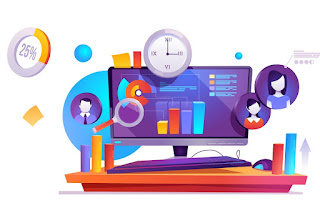Decoding Martian Logic: A Comprehensive Exploration of HRIS, Applicant Tracking Systems, and Employee Onboarding Software
Introduction:
In the vast landscape of human
resources and workforce management, the terminology can sometimes feel as alien
as deciphering Martian logic. Three integral components that contribute
significantly to the efficiency of HR operations are HRIS (Human Resources
Information System), Applicant Tracking System (ATS), and Employee Onboarding
Software.
Understanding HRIS (Human
Resources Information System):
HRIS, often considered the
backbone of modern HR management, is a comprehensive software solution that
integrates various HR functions into one platform. It acts as a centralized
repository for employee data, streamlining processes and enhancing
organizational efficiency. The core functionalities of HRIS include:
Employee Information Management:
HRIS simplifies the task of
managing vast amounts of employee data. From personal details to professional
qualifications, it provides a centralized database accessible to authorized
personnel. This not only reduces the risk of data discrepancies but also
ensures quick retrieval of accurate information.
Payroll Processing:
Automation of payroll processes
is a key feature of HRIS. Calculating salaries, taxes, and other deductions
becomes more accurate and less time-consuming, freeing up HR professionals to
focus on strategic tasks.
Time and Attendance Tracking:
With features like time clock
integration and attendance tracking, HRIS helps organizations monitor employee
work hours more efficiently. This not only ensures fair compensation but also
aids in identifying patterns that can be useful for workforce planning.
Benefits Administration:
HRIS facilitates the management
of employee benefits, from health insurance to retirement plans. It provides
employees with easy access to their benefit information, promoting transparency
and reducing administrative overhead.
Performance Management:
Tracking and evaluating employee
performance becomes more streamlined with HRIS. This includes setting goals,
conducting performance reviews, and identifying areas for improvement. The data
collected assists in making informed decisions about promotions, training, or
development opportunities.
Compliance and Reporting:
Staying compliant with labor laws
and regulations is a critical aspect of HR management. HRIS systems generate
reports that help organizations monitor compliance and respond promptly to any
discrepancies.
Decoding Applicant Tracking
Systems (ATS):
When it comes to attracting,
screening, and hiring new talent, the Martian logic of Applicant
Tracking System comes into play. An ATS is a specialized software
designed to automate the recruitment process, making it more efficient and
effective. Here are the key components of an ATS:
Resume Parsing:
ATS employs advanced algorithms
to parse resumes and extract relevant information. This feature enables
recruiters to quickly review and assess candidate qualifications, saving
valuable time in the initial stages of recruitment.
Job Posting and Candidate Sourcing:
Creating and posting job openings
on various platforms is a breeze with an ATS. It also assists in sourcing
candidates by scanning online profiles and databases, widening the talent pool
and ensuring a more diverse set of applicants.
Application Tracking and Status Updates:
ATS provides a centralized
platform for tracking the status of applications. Recruiters can efficiently
manage the workflow, communicate with candidates, and update the status of
applications in real-time.
Collaborative Hiring:
Collaboration among team members
involved in the hiring process is crucial. ATS facilitates communication and
feedback sharing among recruiters, hiring managers, and other stakeholders,
fostering a more collaborative and transparent hiring process.
Interview Scheduling and Automation:
Coordinating interviews can be a
logistical challenge. ATS automates the scheduling process, sending reminders
to both candidates and interviewers, ensuring a smooth and organized interview
experience.
Analytics and Reporting:
Like HRIS, ATS generates analytics
and reports that provide insights into the effectiveness of recruitment
strategies. This data-driven approach allows organizations to refine their
hiring processes continuously.
Navigating the Terrain of
Employee Onboarding Software:
Once the recruitment journey
concludes, the next Martian logic puzzle to solve is employee onboarding. Employee Onboarding
Software is designed to facilitate the seamless integration of new
hires into the organization. Key features include:
Digital Documentation and Compliance:
Onboarding software allows new
employees to complete necessary documentation digitally. This not only reduces
paperwork but also ensures compliance with legal and organizational
requirements.
Orientation and Training Modules:
A well-designed onboarding system
includes orientation and training modules. This helps new employees acclimate
to the company culture, understand their roles, and acquire the necessary skills
to excel in their positions.
Task Automation:
Onboarding involves a series of
tasks, from setting up email accounts to assigning mentors. Onboarding software
automates these processes, reducing the likelihood of oversights and ensuring a
consistent onboarding experience for all new hires.
Integration with HRIS and ATS:
Seamless integration with HRIS
and ATS is crucial for a holistic approach to human resource management. Data
continuity ensures that employee information seamlessly flows from the
recruitment phase through onboarding and beyond.
Feedback and Evaluation:
Gathering feedback from new hires
about their onboarding experience is essential for continuous improvement.
Onboarding software often includes features for collecting feedback and
evaluating the effectiveness of the onboarding process.
Cultural Integration:
Employee Onboarding Software
plays a role in cultural integration. It helps in communicating organizational
values, mission, and vision to new employees, fostering a sense of belonging
and alignment with company objectives.
In the ever-evolving landscape of
HR technology, the Martian logic of HRIS, ATS, and Employee Onboarding Software
plays a pivotal role in shaping modern workforce management. These systems not
only streamline processes but also empower HR professionals to make data-driven
decisions, enhance employee experiences, and contribute to the overall success
of the organization. As we continue to decode the intricacies of these systems,
it becomes clear that the synergy between HRIS, ATS, and Employee Onboarding Software
is the key to unlocking the full potential of human capital in any
organization.

Comments
Post a Comment